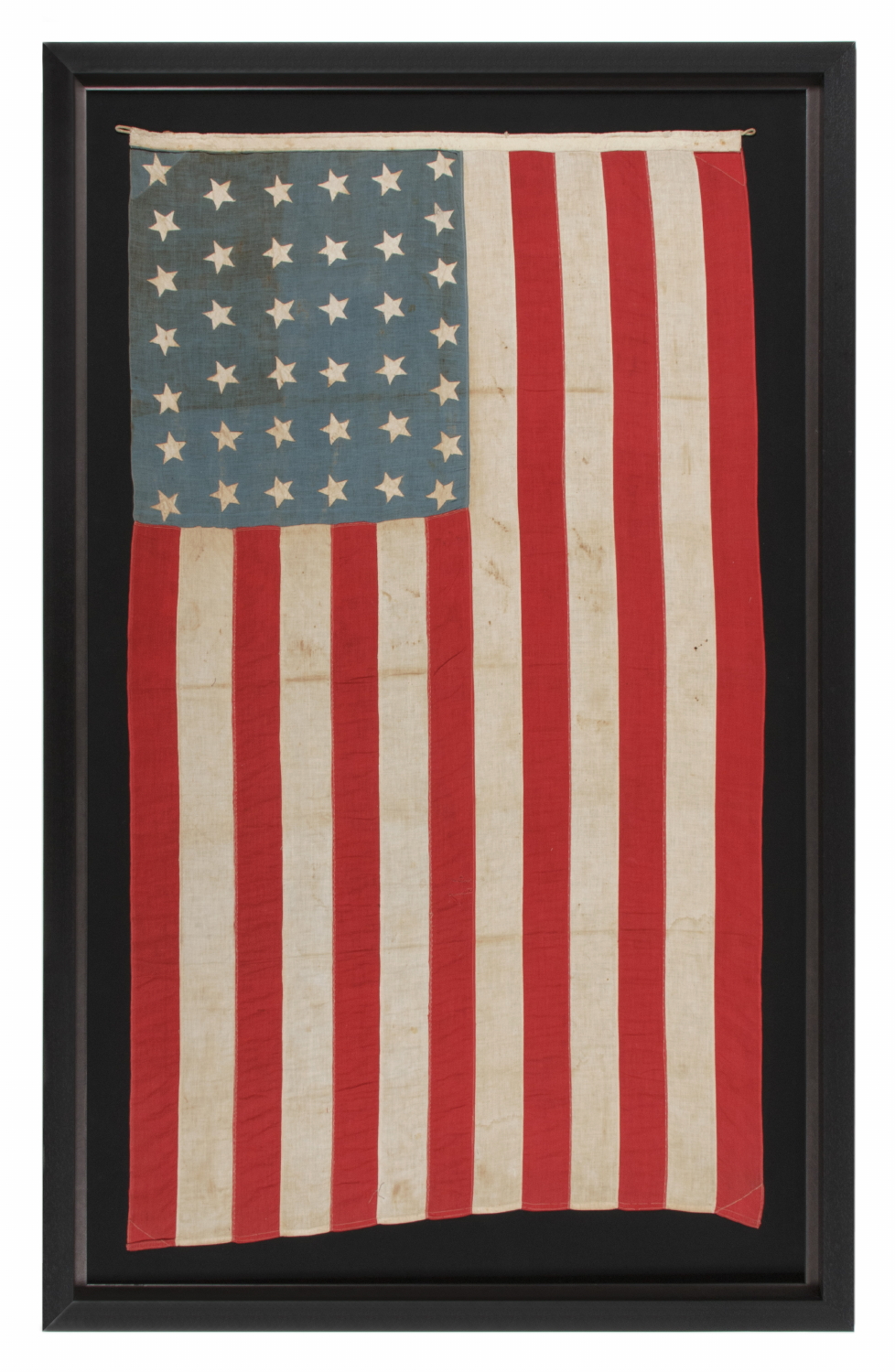
| |
38 STARS ON A HOMEMADE FLAG WITH A CORNFLOWER BLUE CANTON, COLORADO STATEHOOD, 1876-1889 |
|
| Available: |
Sold |
| Frame Size (H x L): |
80" x 49.75" |
| Flag Size (H x L): |
70" x 39.5" |
|
| Description....: |
|
38 STARS ON A HOMEMADE FLAG WITH A CORNFLOWER BLUE CANTON, COLORADO STATEHOOD, 1876-1889:
38 star American national flag, made of cotton bunting and in a desirable small size among its counterparts with pieced-and-sewn construction. Note how the hand-sewn stars are crudely appliquéd to a canton with attractive cornflower blue coloration. These are configured in lineal rows of 7-6-6-6-6-7, and while essentially placed one point facing upward, their positioning was made inconsistent by the homemade nature of the flag's construction. Appliqué work is much more difficult that piecework and it is obvious that the maker was not regularly engaged in flag-making. These sort of features lend nice folk qualities to the design and a pleasant appearance.
Colorado became the 38th state on August 1st, 1876. This was the year of our nation’s centennial of independence from Great Britain. Although 37 remained the official star count for the American flag until 1877, flag-making was a competitive venture and no one wanted to be making 37 star flags when others were making 38’s. It is for this reason that 38 and 13 stars (to represent the original 13 colonies) are more often seen at the Centennial International Exposition in Philadelphia. In 1876, some flag-makers were actually producing 39 star flags, in hopeful anticipation of the addition of the Dakota Territory, but the 39th state would not actually arrive for another 13 years, when the Dakotas came as two states instead of one on November 2nd, 1889. Because stars were officially added on the 4th of July following a state's addition, the 38 star flag became official on July 4th, 1877 and remained so until July 3rd, 1890. On the following day, 43 became the new count, adding stars for the Dakotas, Montana, Washington, and Idaho, all of which had gained statehood during the previous "flag year."
During the 19th century, flags with pieced-and-sewn construction (as opposed to printed) were typically eight feet long or larger. This is because they were important in their function as signals, meaning that they needed to be seen and recognized from a great distance. Even flags made for decorative purpose were generally very large by today’s standards. A small flag was six feet in length, like this example. Smaller flags were even more unusual. Since the average 19th century sewn flag can be cumbersome to frame and display in an indoor setting, many collectors prefer printed parade flags and smaller sewn flags, like this one, the size of which provides a good balance between visual impact and versatility.
Construction: The stars of the flag are made of cotton, hand-sewn and double-appliquéd (applied to both sides) The canton and stripes of the flag are made of cotton bunting that has been pieced with treadle stitching. There is a cotton sleeve along the hoist, bound with treadle stitching, into which a braided cotton cord was threaded, stitched into place by hand along the outer edge, and looped at the top and bottom.
Mounting: The flag has been hand-stitched to 100% cotton, black in color, that has been washed to reduce excess dye. An acid-free agent was added to the wash to further set the dye and the fabric was heat-treated for the same purpose. The mount was then placed in a substantial, black-painted, Italian molding of excellent quality, to which a black-painted, silver gilded and distressed liner was added. The glazing is U.V. protective Plexiglas.
Condition: There is significant oxidation on the obverse side in the top 2/5 of the canton, which shows through though is much lighter on the reverse. There is minor soiling and fading throughout. Many of my clients prefer early flags to show their age and history of use. |
|
|
|
| Collector Level: |
Intermediate-Level Collectors and Special Gifts |
|
| Flag Type: |
Sewn flag |
|
| Star Count: |
38 |
|
| Earliest Date of Origin: |
1876 |
|
| Latest Date of Origin: |
1889 |
|
| State/Affiliation: |
Colorado |
|
| War Association: |
1866-1890 Indian Wars |
|
| Price: |
Please call (717) 676-0545 or (717) 502-1281 |
|
| |
Views: 2917 |
|
|
|

